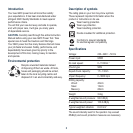5
c. Disconnect the plug from the power source before
making any adjustments, changing accessories, or
storing power tools.
Such preventive safety measures
reduce the risk of starting the power tool accidentally.
d. Store idle power tools out of the reach of children and
do not allow persons unfamiliar with the power tool
or these instructions to operate the power tool.
Power
tools are dangerous in the hands of untrained users.
e. Maintain power tools. Check for misalignment or
binding of moving parts, breakage of parts and
any other condition that may affect the power tools
operation. If damaged, have the power tool repaired
before use. Many accidents are caused by poorly
maintained power tools.
f. Keep cutting tools sharp and clean. Properly maintained
cutting tools with sharp cutting edges are less likely to bind
and are easier to control.
g. Use the power tool, accessories and tool bits etc.,
in accordance with these instructions and in the
manner intended for the particular type of power
tool, taking into account the working conditions and
the work to be performed.
Use of the power tool for
operations different from those intended could result in a
hazardous situation.
5. Service
a. Have your power tool serviced by a qualified repair
person using only identical replacement parts.
This
will ensure that the safety of the power tool is maintained.
Additional safety rules for drills
Wear ear protectors with hammer drills.
Exposure to noise can cause hearing loss.
Use auxiliary handles supplied with the tool.
Loss of control can cause personal injury.
• Fully unwind cable drum extensions to avoid potential
overheating.
• When an extension cable is required, you must ensure
that it has the right ampere rating for your power tool and
is in safe electrical condition.
• If possible, always use clamps or a vice to hold your work.
• Always switch off before you put the drill down.
• Ensure that the lighting is adequate.
• Do not put pressure on the drill, such that it slows the
motor down. Allow the drill bit to cut without pressure. You
will get better results and you will be taking better care of
your tool.
• Keep the area free of tripping hazards.
• Do not let anyone under 18 years operate this tool.
• Only use accessory bits in good condition.
• Before drilling, check that there is sufficient clearance for
the drill bit under the work piece.
• Do not touch the bit after operation. It will be very hot.
• Keep your hands away from under the work piece.
• Never use your hands to remove sawdust, chips or waste
close by the bit.
• Rags, cloths, cord, string and the like should never be left
around the work area.
• Support the work properly.
• If you are interrupted when operating the drill, complete
the process and switch off before looking up.
• Periodically check that all nuts, bolts and other fixings are
properly tightened.
• When using the drill, use safety equipment including
safety glasses or shield, ear defenders, and protective
clothing including safety gloves. Wear a dust mask if the
drilling operation creates dust.
WARNING. Before connecting a tool to a power source
(mains socket power point receptacle, outlet, etc.) be sure
that the voltage supply is the same as that specified on the
nameplate of the tool. A power source with a voltage greater
than that specified for the tool can result in serious injury to
the user, as well as damage to the tool.
If in doubt, do not plug in the tool. Using a power source
with a voltage less than the nameplate rating is harmful to
the motor.














